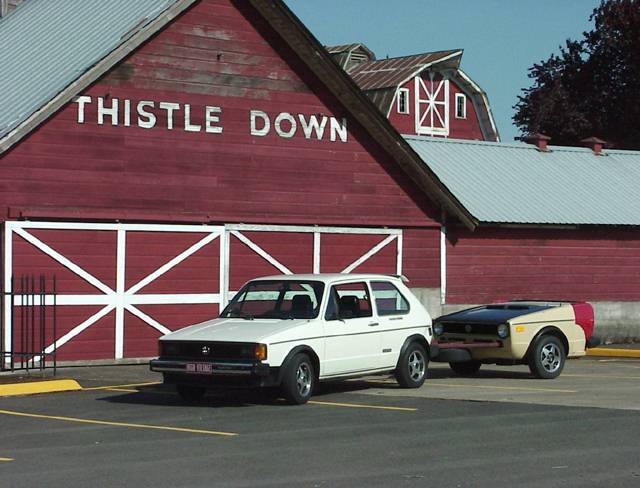Update on the Pusher, 2004
Well, it's been a quiet year for the Pusher, as I haven't attended many events, car shows or other exhibitions with the EV, so I didn't need the trailer to transport the Rabbit long distances.
There was one small local VW show that I went to, taking the EV and Pusher out to show it. Of course, there was lots of interest, and I met up with some familiar faces.
Mostly, I haven't been using the EV for anything but trips to the grocery because I was losing range rapidly due to battery failure. For about the last year, I had noticed that the car fatigued quickly, and since the beginning of the year, I was unable to take it over the river to the other side of town because it was just too tired to make the freeway speeds necessary to come home.
What this means to the Pusher is that I was unable to run the car and trailer in parallel hybrid mode to any meaningful extent. The batteries in the car were just so much dead weight for the most part, and the Pusher would have to provide all of the motive power.
I had considered taking the EV/Pusher over to John Day for SolWest 2004, but going out into the desert without sufficient battery capacity seemed a big mistake. Running in parallel hybrid mode, I need about 25 ampere hours to assist the trailer in climbing Santiam pass. By the middle of the year, I was down to about 5 miles of electric only operation in the EV, or about 15 ampere hours.
I ended up driving my other biodiesel-powered Rabbit to the SolWest event.
After returning from SolWest, I decided that it was time to find out why the EV was losing range (OK, so I should have done this much sooner, right. If I had so much free time, I wouldn't have so many unfinished projects.). What I found is that three of the 6-volt Trojan T-105 batteries were near death, with one suffering polarity reversal under high load. Two others of the batteries were in a weakened state. The other 13 batteries in the traction pack were fine.
When I bought these new batteries two years ago, I was told that it was a very bad idea to tap off lower voltage to run the Link 10 meter, using three of the series-connected batteries to supply 18 volts to run the meter. "How bad could it be?" I asked myself, and proceeded to tap them anyway. Late last year I had noticed that the Link 10 would lose power under heavy acceleration, so I tapped higher on the pack, adding two more batteries for a total of 30 volts. Well, now I had my answer, it could be [i]really bad[/i]. Since the Link 10 draws a small amount of current 24 hours a day, the three batteries (then the five) were being discharged at a different rate than the rest of the pack. When the car was being charged, the were charging at a different rate, reaching full charge later than the rest. Eventually, these three batteries sulfated from improper charging, and died an untimely death.
My solution to this problem is also less than ideal. I replaced the five batteries that were showing signs of sulfation. It's not recommended to mix-n-match batteries of different ages in a series-connected string, but an entire new set of batteries these days would have run almost $1200. If replacing just the five weak ones will get me a couple of more years of service, it'll be worth it.
The Link 10 is now powered by it's own gel cell battery, salvaged from a computer UPS and charged by it's own line-powered charger. I have located some DC-to-DC converters, and will eventually power the Link 10 from the EV's auxiliary battery.
As of now, the EV seems to be back to it's normal range, and I no longer suffer severely low battery voltages after a few miles. What this means for the Pusher is that I can now contemplate going on some longer trips without having to worry that a breakdown of the trailer will strand me with no method of being able to drive to a service station or telephone.
Last week, I put a brand new set of Goodyear Invicta GLR low rolling resistance tires on the EV to replace the old set, which were so bald that the cord was sticking out from the tread. It's a big relief to not slide around the corners in the rain anymore!
I did have one interesting contact with an editor of Farm Show magazine, and supplied them with a 200 word article about the Pusher for their June issue. Farm Show is a newsprint-type magazine filled with handy tips, home-built machinery and interesting stories from across the country. It carries no advertising and is aimed at farmers and agricultural enterprises.
Here’s a picture I provided them for the article:

Anyway, at this point the body work on the Pusher is still not finished, so it’s been put in the car shed under tarps for the winter to keep it dry. Maybe next year I’ll have the opportunity to take it on new and exciting adventures.
Original material ©1996-2025 Mr. Sharkey | All rights reserved
